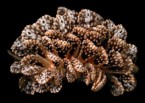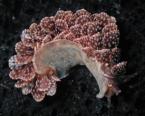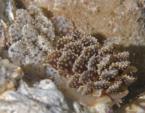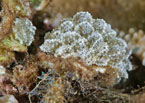_______________
Additional Photos

side

underside

light & dark

with Halimeda

young
_______________
GALLERY

|
Cyerce pavonina Bergh, 1888

Maximum size: 37 mm.
Identification:
Mature
specimens
of
this species have wedge shaped cerata with evenly
distributed tubercles. The cerata are frosted with white dorsally and
the spaces between the tubercles are brown. There are one or two small
dark "windows" on the dorsal surface of each ceras and a burnt orange
line runs along its margin. The rhinophores and notum have extensive
brown
pigment. However, the overall pattern of mature animals may very
considerably from "light" to "dark." In very young animals, the cerata are
more strongly inflated
and pillow-like with tuberculate margins. They are largely transparent
with white frosting and small brown internal spots corresponding to the
central "windows" of mature cerata. They also contain small greenish
spheres (retained algae?). As the animals grow, the cerata become
flatter and develop a reticulate pattern of dark lines that gradually
expands into the broader dark pigmentation seen in the cerata of mature
individuals. Occasional juveniles may lack all or most dark markings.
Natural history:
Cyerce pavonina is
a
moderately rare species found in moderately protected to exposed rocky
habitats from < 1 to 7 m (< 3 to 23 ft). It seems most common at
the shallower and more exposed end of that distribution. We've found it
on
samples of Halimeda discoidea
but we haven't confirmed feeding on that algae. A 37 mm animal laid a
roughly oval, cream egg mass 41 mm long by 14-17 mm wide. The egg
ribbon was about 3 mm thick.
Distribution:
Maui, Oahu, Kauai and French Frigate Shoals: widely distributed in the
Indo-Pacific and, perhaps, the eastern Pacific.
Taxonomic notes:
This
appears
to be the species tentatively listed as Cyerce
nigricans (Pease, 1866) in Kay, 1979. Cyerce orteai Valdes &
Camacho-Garcia (2000) from the eastern Pacific may prove to be a synonym
with further work. It was first recorded in Hawaii
at Hauula, Oahu by Scott Johnson on April 2,
1978.
Photo: John
Hoover: top, about 37 mm: found by CP; near Diamond Head, Oahu;
Oct. 1, 2000.
Observations and comments:
Note
1: ( )
|
|






